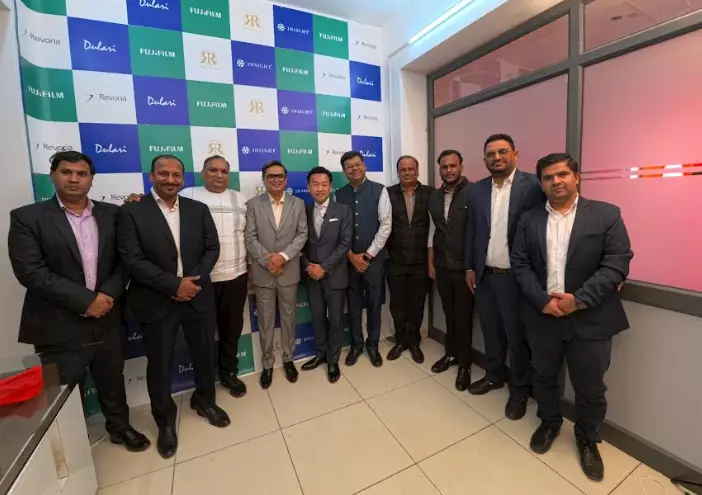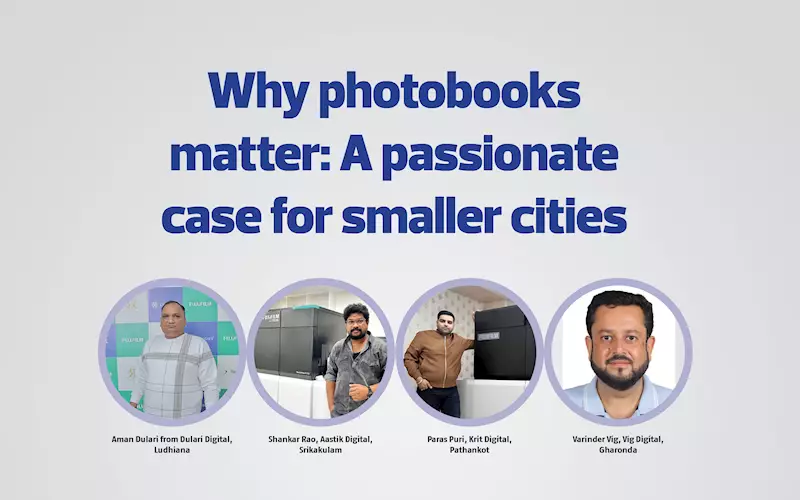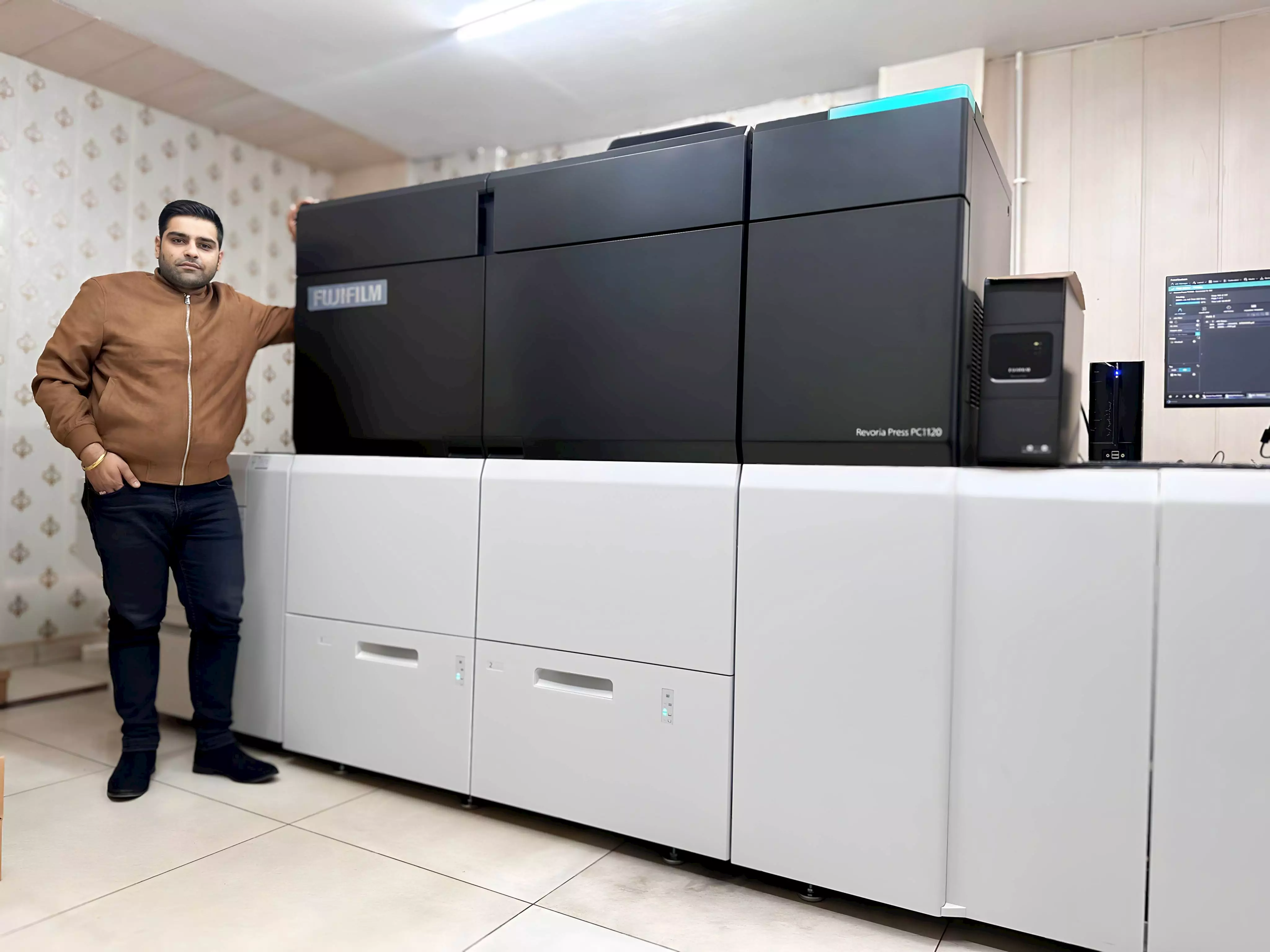Why photobooks matter: A passionate case for smaller cities - The Noel DCunha Sunday Column
Photo albums capture memories of events like weddings, birthdays, and vacations. In India, weddings are grand events, not just in metros but in tier-2 and tier-3 cities, with the wedding industry estimated to be USD 30-bn. The photobook market was estimated to be USD 3.41-bn in 2023. By 2029, it is set to grow to USD 4.42-bn.
In this Sunday Column, four digital photobook specialists from Ludhiana, Pathankot, Gharonda and Srikakulam discuss the boom in photobooks in the digital age
28 Jan 2024 | By Noel D'Cunha
Aman Goel from Dulari Digital, Ludhiana

Dulari digital team with Fujifilm and Insight team
The Ludhiana market primarily caters to 12x36-inch photo sizes that constitute 90% of the demand. The remaining 10% comprises other photo sizes, such as 13x39-inch and 14x40-inch. “The market has around 16 to 17 digital printing labs that serve approximately 25,000 photographers,” says Aman Goel from Dulari Digital, Ludhiana.
Dulari Digital produces 250 photobooks daily, with a 50:50 ratio of photo album and commercial print production. “Our production process is centred on digital photo printing, representing over 95% of our business,” informs Goel.
Despite the numerous advantages of digital printing, Goel faces several challenges that it mitigates during the pre-press stage. “Since personalisation services require significant attention from each customer, we do not offer them to avoid affecting our production jobs. However, our digital machines have revolutionised the printing of pictures and commercial jobs, making the workflow smoother and more effortless,” explains Goel, explaining, “The turnaround time is significantly reduced, while the press has the ability to convert RGB to CMYK. Post-press features are executed using digital equipment, and streamlined hardbound covers are managed through an efficient process.
As a show business item, keeping abreast of the latest trends and adjusting products accordingly is essential. “The better the product looks, the more value it creates for printing press owners, photographers, and end customers,” says Goel.
Starting a new business is always daunting, and photo album manufacturing is no exception. “At Dulari Digitals, we were fortunate to launch this business 30 years ago, and this period played a significant role in our current achievements,” says Goel.
Although Goel has yet to implement the web-to-print concept, Goel says it holds great potential, and we look forward to adopting it in the future to meet our customers' demands.
Shankar Rao, Aastik Digital, Srikakulam

M Shankar Rao, owner at Aastik Print Zone
Srikakulam, a bustling region in India, is home to a thriving photography industry. With 2,000 photographers, one lab, one Konica lab, and three offset printing setups, the region is known for producing high-quality photo albums. Customers in the area typically order albums in the popular sizes of 13x19-inch and 14x14-inch.
Aastik Digital, a new venture in the region, specialises in printing digital sheets in the sizes of 12x36-inch and 12x35-inch. “We offer album sizes ranging from 17x24-inch to 15x24-inch and have a daily album production capacity of 20,” says Shankar Rao, Aastik Digital, the photobook specialist in the city. While Aastik Digital's primary focus is photo album printing, it has recently expanded into printing wedding cards.
Aastik Digital's customers have embraced digital printing, abandoning manual processes in favour of adopting new technology. The company uses calibration by engineers and AI auto-correction functions to meet the evolving trends in photography. “Our team ensures that every print and album meets customer requirements, from pre-press to post-press,” says Rao.
Recently inaugurated, Aastik Digital plans to assess the performance of its equipment in six months. “However, based on our 25 years of experience in photography, Fujifilm Revoria 1120's performance is impressive in terms of colour and quality compared to other printers,” says Rao. The company hopes that its adoption will facilitate its business growth.
While Aastik Digital provides embossing services, personalisation is limited in this small city, says Rao.
Staying updated with the latest industry trends is crucial for the photo album-making business. Rao prioritises attending expos to remain informed about market trends and seize growth opportunities. “Additionally, we stay connected with our customers to understand their changing needs and preferences.”
Meticulous planning is crucial before initiating a photo lab business. Rao says, Aastik Digital My journey involved meticulous planning over four years before initiating the photo lab.
“We believe that the plan was perfect for the operation.”
As Aastik Digital operates in a rural area, web-to-print adoption is relatively low. Therefore, the company focuses on meeting its customers' demands through traditional methods. “We remain open to adopting new technologies if the need arises,” concludes Rao.
Paras Puri, Krit Digital, Pathankot
Paras Puri Krit Digital
Paras Puri, owner of Krit Digital, shares fascinating insights into the world of photo printing in Pathankot. According to Paras, there is only one print label and one lab that offers silver halide prints in the area, which is home to around 100 photographers. The most popular album sizes in the region are 12x36 inches and 14x40 inches.
Krit Digital is a leading player in the industry, producing around 6,000 sheets and 100 albums daily. Puri explains that photography services account for 20% of their business, while photo frames and other products make up 10%, and photo albums comprise a significant 70%. Puri also estimates that approximately 85% of the photo business has shifted from traditional silver halide to digital photo printing.
The industry has witnessed a significant shift in photography trends, with staged photography no longer in fashion. Wedding photographs are taken both indoors and outdoors, and photographers aim to capture the right balance of colours, lights, and emotions. “Most of the pre-press work is done at the design stage of photobooks, either by the customer or Krit Digital to match their requirements,” says Puri.
Customers expect instant results and deliveries in today's fast-paced world, forcing the industry to adapt to the changing landscape. The latest equipment has become essential to match the need for speed while maintaining high-quality standards. “The Fujifilm Revoria PC 1120 press is an excellent solution for meeting clients' specific quality standards.”
Krit Digital prides itself on offering personalised services to its clients. The team does not embellish photos but instead tries to meet specific requirements in the design stage of the photobook, ensuring that the final product meets the client's expectations.
According to Puri, any photo album-making business must stay updated with the latest industry trends to take advantage of the upcoming surge in demand. “The printing presses are the heart of the business, and staying up-to-date with the equipment is vital,” explains Puri. “Additionally, companies should develop value-added services and new offerings to enhance their presentation.”
Creating a finished photobook involves numerous steps, and it is crucial to understand each of them thoroughly. Puri says, “A single mistake at any point in the process could lead to the entire photobook needing to be redone, resulting in a significant loss of time and money. Having a professional team with active problem-solving skills and backup plans in case of machine malfunction is critical.”
Puri advises businesses to focus on the above points when starting or looking to start a new business. ”This will enable them to stay ahead of the curve and remain competitive in the ever-evolving photo printing industry,” concludes Puri.
Varinder Vig, Vig Digital, Gharonda

Vig digital team with Fujifilm team during Inauguration
In the photo album market, the size of the album is crucial. “In Gharonda, the standard size is 12x36-inch. However, we have an advantage as we can now produce 13x40-inch size albums using Fujifilm Revoria PC 1120. This has helped us cater to a larger audience,” says Varinder Vig, owner of Vig Digital in the city.
Gharonda has 10-12 photo print labs and around 200-250 photographers. “We produce approximately 8,000 sheets and 150 albums per day, depending on the wedding season,” informs Vig. Besides photo albums, Gharonda produces school students' ID cards and yearly group photo cards, catalogue printing, and other commercial jobs. “However, our focus is on photo album printing, which constitutes 70% of our business,” says Vig.
The industry's shift from silver halide to digital photo printing is evident. “In our location, we estimate that approximately 70% of the silver halide business has moved to digital printing,” says Vig.
Wedding photography has evolved, and we have adapted to meet our customers' requirements. We have a pre-press team with colour management knowledge and can make press adjustments according to the need. We have invested in post-press equipment for different lamination and binding effects to provide our customers with a wide range of options. The printing machines have played a vital role in our business growth.” We have all the necessary post-press machinery and expertise in photobook production. Fujifilm Revoria PC 1120 has been a significant help in providing high-quality prints with a unique RGB workflow,” Vig confirms.
What about photo enhancements or adding a personal touch to the prints? “Personalisation is essential in photo albums. We offer foiling and other enhancements to make each album unique,” explains Vig.
While it is important for a photo album-making business to stay up-to-date with the latest industry trends, it all about photo quality that matters, says Vig. “The right equipment and team is essential when starting a photo album printing business. However, constant learning and improvisation are crucial for success.”
Photo album businesses are shifting to web-to-print to meet customers' demands for easy ordering and delivery. In Gharando, it's primarily offline orders that are still prevalent in the city’s market. “We strive to provide our customers with easy ordering and delivery options to ensure their satisfaction,” concludes Vig.












 See All
See All